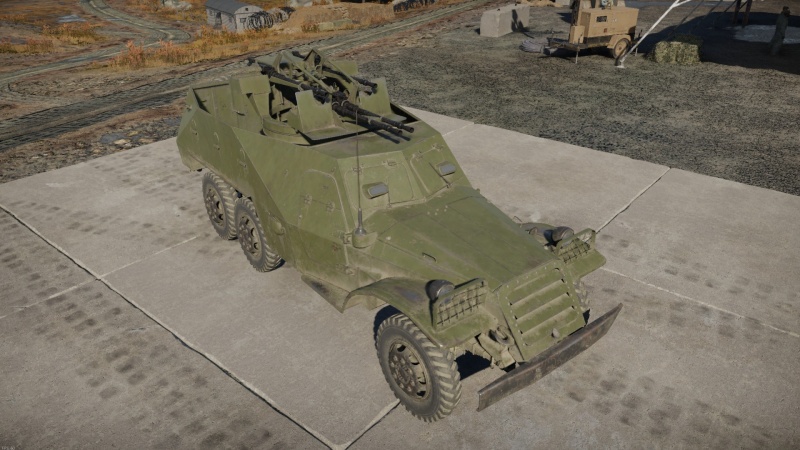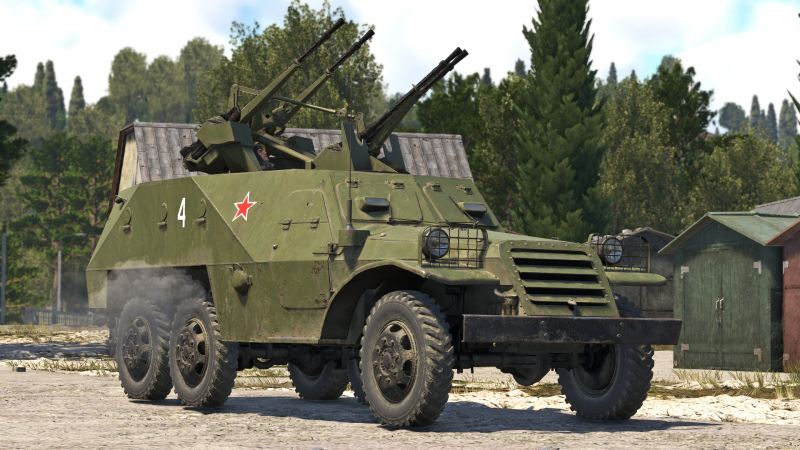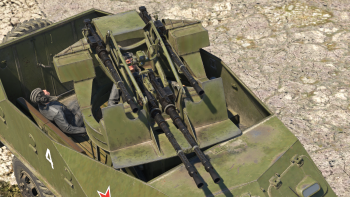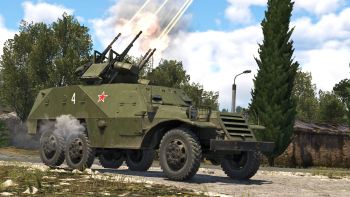BTR-152D
| This page is about the Soviet SPAA BTR-152D. For the other version, see BTR-152A. |
Contents
Description
The BTR-152D is an improved variant of the BTR-152-based self-propelled anti-aircraft gun family. The design incorporates four 14.5 mm KPVT heavy machine guns in a quad mount, increasing the vehicle's firepower over the previous BTR-152A. Other enhancements include an external tire pressure regulation system, a front-mounted winch, and night vision devices for the driver.
Introduced in Update "Kings of Battle", the BTR-152D is very similar to its predecessor. However, firepower is greatly increased, making it much easier to bring down enemy aircraft. Armor-piercing ammunition can penetrate significant armor at close ranges. Nonetheless, it is still lightly armoured and is not recommended to be used to primarily engage enemy ground vehicles.
General info
Survivability and armour
As the BTR-152D is an armored personnel carrier, its armor is very light compared to tanks. However, relative to other truck-based anti-aircraft vehicles, it has a relatively good armor profile. Its armor, although light, can protect the crew against light machine gun fire and shrapnel. In fact, due to the thinness of the armor, it may prevent incoming APHE ammunition from detonating, causing the round to overpenetrate. Although the armor can shrug off small-caliber machine guns, vehicles fitted with heavy machine guns and autocannons can easily punch through the armor and take out the crew rapidly.
The cabin and troop compartment are semi-enclosed, having side armor but lacking a roof. This means that attacking aircraft and machine guns positioned higher than the BTR-152D's roof line will be able to easily hit crew members. The turret is essentially unarmored except for a thin gunshield that does not elevate with the guns, meaning that it will not protect against aircraft coming from high angles. The lack of a roof also means that high-explosive weapons will easily overpressure this vehicle, whether connecting with it directly or detonating nearby. Although rare, Incendiary weapons will burn the crew near-instantaneously if flames get inside the vehicle.
The crew size of the BTR-152D is relatively large, meaning that the vehicle can lose more crewmembers than other vehicles while staying operational. However, the crew are situated very close to each other, meaning that enemy fire that penetrates the armor can take out most if not all of the crew in quick succession.
Due to the overall armor profile, it is inadviseable to rely on the BTR-152D's armor. It is recommended to play carefully, similar to other anti-aircraft vehicles, trying not to get hit.
Armour type:
- Rolled homogenous armor (Hull, Gunshield)
- Structural steel (Wheel wells, Bumper)
- Bulletproof glass (Viewing ports)
| Armour | Front (Slope angle) | Sides | Rear | Roof |
|---|---|---|---|---|
| Hull | 13 mm (34-64°) Grille 13 mm (42°) Cabin 12 mm (42°) Viewing ports 6 mm (84°) Hood 3 mm (0°) Bumper |
10 mm (7-22°) Cabin 10 mm (7°) Doors 10 mm (0°) Sides 10 mm (7-23°) Rear 6 mm (0-38°) Wheel wells |
8 mm (0°) Rear 10 mm (0°) Spare tire 6 mm (0°) Rear bumper |
6 mm (87°) Cabin |
| Turret | 6 mm (16°) Gunshield 10 mm (0°) Gun mount |
6 mm (0°) Ammunition 6 mm (0°) Turret ring |
6 mm (6-10°) Gun mount 6 mm (0°) Turret ring |
6 mm (90°) Gunshield 0 mm (0°) Turret roof |
Notes:
- Wheels are 10 mm thick
- Gunshield section rotates horizontally with the turret, covering different small sections of the hull depending on its position
Mobility
The mobility of the BTR-152D is decent overall, being able to reach relatively high forward speeds on road and decent speeds offroad for a wheeled vehicle. Compared to its maximum forward speed, the vehicle's reverse is relatively lackluster, although not terrible. Before driving over hills or around corners, it is recommended to check for enemies that might force a retreat. Researching Mobility modifications will noticeably improve the vehicle's performance.
Keep in mind that due to the BTR-152D's relatively light weight and low engine power, obstacles such as fences and light vegetation will significantly slow it down if hit, while large trees will completely stop the vehicle.
| Game Mode | Max Speed (km/h) | Weight (tons) | Engine power (horsepower) | Power-to-weight ratio (hp/ton) | |||
|---|---|---|---|---|---|---|---|
| Forward | Reverse | Stock | Upgraded | Stock | Upgraded | ||
| Arcade | Expression error: Unexpected * operator. | 156 | Expression error: Unexpected round operator. | __.__ | |||
| Realistic | 97 | Expression error: Unexpected round operator. | __.__ | ||||
Modifications and economy
One recommended order of research is as follows:
- Improved Parts and Improved FPE: These are high-priority modifications and will significantly improve the BTR-152D's ability to return to combat after taking damage.
- Adjustment of Fire: This modification will improve weapon groupings and increase accuracy.
- Elevation Mechanism and Horizontal Drive: As the BTR-152D is an anti-aircraft vehicle, it is recommended to hold weapon handling modifications in high priority. These will increase the ability to track enemy aircraft by decreasing the time for weapons to be brought onto the target.
- IAI and API-T: Although the default Universal ammunition is very potent, players may opt to research and choose between IAI (Immediate-Action Incendiary) and API-T (Armor-Piercing Incendiary, Tracer) ammunition belts. IAI ammunition belts contain more IAI ammunition than other belts, which is very potent against aircraft and can easily set fire to aircraft fuel tanks and engines. API-T ammunition belts contains the AP-I(c) (Armor-Piercing, Incendiary, cermet core) round which has 10 mm of increased armor penetration over the standard API-T round. This belt focuses on armor penetration and can be used against heavy aircraft armor and against lighty armored ground vehicles.
- Brake System: Due to the BTR-152D's high top speed, it may be difficult to slow the vehicle down when going at its maximum speed. This modification will reduce the time it takes for the vehicle to stop and can possibly prevent the vehicle from driving off ledges or rolling past cover.
- Crew Replenishment: Due to the lack of an armored roof, crewmembers will often be knocked out by enemy aircraft's strafing runs. This modification will increase the vehicle's survivability.
- General Mobility: These modifications will increase the vehicle's mobility, allowing it to reach higher top speeds faster than before. Since it is not recommended to drive the BTR-152D to the front lines, these modifications may be researched later than others.
- Artillery Support: If using the BTR-152D in a more frontline role, this modification can allow for periodic calling of artillery in a designated sector which is capable of knocking out enemies. This may be useful if there are other anti-aircraft vehicles nearby.
Armaments
Main armament
Players who are experienced with the earlier BTR-152A will find the BTR-152D's weapon handling to be nearly identical, as it is essentially the same vehicle fitted with an extra two KPVT machine guns, increasing the weapon total to four.
Weapon traverse is fast and can allow players to get their guns on targets fairly quickly. An unusual note about the BTR-152D's weapon handling is that the two machine guns mounted to the top of the turret elevate from a different position than the front two machine guns. This means that overall dispersion slightly increases as the turret elevates higher due to the guns being spaced further apart than when they are lowered. Because of this quirk, these guns may be slightly more accurate when shooting at aircraft that are coming in low.
The 14.5 mm KPVT heavy machine guns fire rapidly and fairly accurately. Although considered a heavy machine gun, its performance is somewhere between a heavy machine gun and an autocannon. Overall armor penetration is very good for its class. API-T and AP-I(c) ammunition can easily penetrate aircraft armor and armored glass, leading to the destruction of important components and possibly sniping the pilot directly. These rounds can also be used to penetrate lightly armored ground vehicles and even the sides of medium tanks at close ranges. IAI ammunition easily lights aircraft fuel tanks and components on fire.
The machine guns have relatively high velocity, meaning that players can lead less when aiming at enemy aircraft and rounds will reach the target faster than other guns. It actually may take a bit of practice for players to get used to these guns, especially if they are used to leading targets with autocannons mounted to previous Soviet anti-aircraft vehicles such as the ZSU-37.
Reload speed is average for the guns' class but not instant. When enemy aircraft are closing in during the reloading process, it may feel like hours. It is recommended to ensure that the machine guns are fully loaded before engaging the enemy. This may involve sitting on a capture point or firing off the remaining belt in order to reload a full belt of ammunition.
It is recommended to fire bursts around four seconds long in order to keep up a good fire rate while not overheating the guns. Overheating the guns will force the gunner to unjam the weapons, which will prevent you from firing until they are reloaded. If this happens during a critical phase of attack, it may result in the BTR-152D's destruction.
| 14.5 mm KPVT (x4) | Turret rotation speed (°/s) | Reloading rate (seconds) | ||||||||||||
|---|---|---|---|---|---|---|---|---|---|---|---|---|---|---|
| Mode | Capacity (Belt) | Fire rate | Vertical | Horizontal | Stabilizer | Stock | Upgraded | Full | Expert | Aced | Stock | Full | Expert | Aced |
| Arcade | 2,400 (150) | 600 | -5°/+89° | ±180° | - | 40.5 | 56.1 | 68.1 | 75.3 | 80.1 | 10.40 | 9.20 | 8.48 | 8.00 |
| Realistic | 27.4 | 32.2 | 39.1 | 43.2 | 46.0 | |||||||||
Ammunition
- Universal: AP-I · API-T · IAI
- API-T: API-T · AP-I(c) · API-T · IAI
- IAI: IAI · API-T
| Penetration statistics | |||||||
|---|---|---|---|---|---|---|---|
| Ammunition | Penetration @ 0° Angle of Attack (mm) | ||||||
| 10 m | 100 m | 500 m | 1,000 m | 1,500 m | 2,000 m | ||
| IAI | 3 | 3 | 3 | 3 | 2 | 2 | |
| API-T | 38 | 35 | 25 | 17 | 11 | 7 | |
| AP-I | 39 | 37 | 27 | 18 | 13 | 9 | |
| AP-I(c) | 49 | 46 | 34 | 23 | 16 | 11 | |
| Shell details | ||||||||||||
|---|---|---|---|---|---|---|---|---|---|---|---|---|
| Ammunition | Velocity (m/s) |
Projectile mass (kg) |
Fuse delay (m) |
Fuse sensitivity (mm) |
Explosive mass (TNT equivalent) (g) |
Ricochet | ||||||
| 0% | 50% | 100% | ||||||||||
| IAI | 1,000 | 0.06 | 0 | 0.25 | 3.4 | 47° | 56° | 65° | ||||
| API-T | 1,000 | 0.06 | - | - | - | 47° | 56° | 65° | ||||
| AP-I | 990 | 0.06 | - | - | - | 47° | 56° | 65° | ||||
| AP-I(c) | 1,000 | 0.07 | - | - | - | 47° | 56° | 65° | ||||
Ammo racks
| Full ammo |
1st rack empty |
2nd rack empty |
3rd rack empty |
4th rack empty |
5th rack empty |
6th rack empty |
Visual discrepancy |
|---|---|---|---|---|---|---|---|
| 16 | __ (+__) | __ (+__) | __ (+__) | __ (+__) | __ (+__) | __ (+__) | __ |
Usage in battles
There are a few ways to play the BTR-152D, although its main role is as an anti-aircraft vehicle.
Anti-Aircraft Role
When performing the anti-aircraft role, it is recommended to stay behind the front lines and attack aircraft as they fly over the battlefield. Players may decide to take IAI ammunition belts to increase anti-aircraft firepower. Since weapon handling is excellent, players may be able to take out multiple aircraft in quick succession as long as they are vigilant and always watching the skies in front, above, and behind them.
It is recommended to give destruction priority to enemy aircraft that carry heavy machine guns, autocannons and/or explosive weapons like bombs and rockets. Bombers such as the He 111 H-16 may fly at higher altitudes to stay away from anti-aircraft fire. If air defense is unsuccessful in taking down the bomber, players can use the BTR-152D's mobility to escape the area or hide behind cover before the bombs hit the ground. Aircraft with rockets such as the M.B.175T may launch salvoes from long ranges. It is recommended look out for these aircraft and hide or counter-attack before they launch their rockets. Aircraft with heavy machine guns and autocannons such as the Bf 110 G-4 can be devastating to the BTR-152D due to their damage output against exposed crewmembers. It is recommended to begin firing at longer ranges before they begin firing, with the 14.5 mm AP ammunition hopefully sniping their pilots.
Be aware that firing for long periods of time will alert enemies to your position. It is recommended to change positions periodically, especially if your position is outside of spawns.
Light Anti-Ground Role
If players have researched API-T belts containing the AP-I (cermet core) round, players may opt to use the BTR-152D as a sort of early infantry fighting vehicle. This ammunition penetrates a generous amount of armor for its size and can easily punch through light targets. Some medium tanks and armored tank destroyers can be penetrated from the sides and rear at close ranges.
Utilizing the BTR-152D's high top speed, players can flank the battlefield and attack enemy vehicles using hit-and-run tactics. If an enemy vehicle's armor cannot be penetrated, players can use the guns to quickly disable the vehicle's tracks and possibly their weapons.
It is recommended to beware of ground vehicles fitted with autocannons or roof-mounted heavy machine guns such as the Wirbelwind or M4A2 as they can penetrate the BTR-152D and wipe out the crew quickly. Enemy anti-aircraft vehicles are particularly dangerous as they primarily use these types of weapons.
Pros and cons
Pros:
- Hull armor can shrug off light machine guns and shrapnel
- Relatively large crew size
- Decent mobility with good forward speed on-road
- Weapon traverse is quick and guns have high velocity
- Four KPVT heavy machine guns can output significant damage against aircraft
- IAI ammunition can easily set aircraft components on fire, API-T and AP-I(c) ammunition can penetrate light to medium armor
- At first glance, the truck chassis may trick enemies into ignoring this vehicle in urban environments
Cons:
- Thin armor can be penetrated by heavy machine guns and autocannons
- Open-topped design means the vehicle is vulnerable to strafing from enemy planes and explosions
- Closely positioned crewmembers
- Mobility is decreased off-road due to wheeled design
- Relatively low engine power and light hull will cause impact with obstacles to slow or stop the vehicle
- Relatively small caliber may not do significant damage against large aircraft at a distance
History
Describe the history of the creation and combat usage of the vehicle in more detail than in the introduction. If the historical reference turns out to be too long, take it to a separate article, taking a link to the article about the vehicle and adding a block "/History" (example: https://wiki.warthunder.com/(Vehicle-name)/History) and add a link to it here using the main template. Be sure to reference text and sources by using <ref></ref>, as well as adding them at the end of the article with <references />. This section may also include the vehicle's dev blog entry (if applicable) and the in-game encyclopedia description (under === In-game description ===, also if applicable).
Media
- Skins
See also
Related development
Vehicles of similar configuration or role
External links
Paste links to sources and external resources, such as:
- topic on the official game forum;
- other literature.
| USSR anti-aircraft vehicles | |
|---|---|
| GAZ-AAA | GAZ-AAA (4M) · GAZ-AAA (DShK) |
| BTR-152 | BTR-152A · BTR-152D |
| Wheeled/Half-tracked | GAZ-MM (72-K) · ZiS-12 (94-KM) · ZiS-43 |
| Radar SPAAG | ZSU-23-4 · ZSU-37-2 |
| SAM | ZSU-23-4M4 · Strela-10M2 · 2S6 · Pantsir-S1 |
| Other | ZSU-23-4M2 · ZUT-37 · ZSU-37 · BTR-ZD · ZSU-57-2 |
| Czechoslovakia | M53/59 |
| North Vietnam | ▂Phòng không T-34 |








